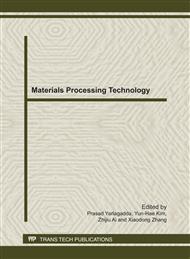[1]
D. E. Jiang and Emily A. Carter, J. Phys. Chem. B, Vol.108, (2004), p.19140.
Google Scholar
[2]
R. I. Hegde, J. M.White, J. Phys. Chem. Vol. 90, (1986), p.296.
Google Scholar
[3]
D. R. Huntley, Surf. Sci. Vol.13, (1990), p.240.
Google Scholar
[4]
R. I. R. Blyth, C.Searle, N.Tucker; R. G.White, T. K Johal, J.Thompson, S. D.Barrett, Phys. ReV. B, Vol.68,(2003), p.205404.
Google Scholar
[5]
P. J. Cote, C. Rickard, Wear, Vol. 17 ( 2000), p.241.
Google Scholar
[6]
J. R.Rice, J. S. Wang, Mater. Sci. Eng., A Vol. 23, (1989), p.107.
Google Scholar
[7]
V.Srikrishnan, H. W. Liu, P. J. Ficalora, Scr. Metall. Vol. 9, (1975),p.1341.
Google Scholar
[8]
C. L.Briant, K.Sieradzki, Phys. ReV. Lett. Vol. 63, (1989), p.2156.
Google Scholar
[9]
P. B. V.Narayan, J. W. Anderegg, C. W. J. Chen, Electron Spectrosc. Relat. Phenom. Vol.27, (1982), p.233.
Google Scholar
[10]
D. R.Baer, M. T.Thomas, R. H. Jones, Metall. Mater. Trans. A:Phys. Metall. Mater. Sci. Vol .15A , (1984), p.853.
Google Scholar
[11]
M. R.Shanabarger, R. D. Moorhead, Surf. Sci. Vol.365, (1996), p.614.
Google Scholar
[12]
H.Cabibil, J. A. Kelber, Surf. Sci. Vol.373, (1997), p.257.
Google Scholar
[13]
P.Hohenberg, W. Kohn, Phys. ReV. B Vol.136, (1964),p.864.
Google Scholar
[14]
W.Kohn, L. J. Sham, Phys. ReV. A, Vol.140, (1965), p.1133.
Google Scholar
[15]
P. E.Blöchl, Phys. ReV. B,Vol.50, (1994), p.17953.
Google Scholar
[16]
G.Kresse, D. Joubert, Phys. ReV. B Vol.59, (1999), p.1758.
Google Scholar
[17]
Perdew, J. P.; Burke, K.; Ernzerhof, M. Phys. ReV. Lett. Vol. 77, (1996), p.865.
Google Scholar
[18]
H. J.Monkhorst, J. D.Pack, Phys. ReV. B Vol. 13 ,(1976), p.5188.
Google Scholar
[19]
M.Methfessel, A. T. Paxton, Phys. ReV. B, Vol. 40, (1989), p.3616.
Google Scholar
[20]
D. E.Jiang, E. A.Carter, Phys. ReV. B, Vol. 67,(2003),p.214103.
Google Scholar
[21]
M.Acet, W. Pepperhoff, Phys.ReV. B Vol. 49, (1994), p.6012.
Google Scholar
[22]
PACK J D, MONKHORST H J. Phys Rev B, Vol. 16, (1977), pp.1-748
Google Scholar
[23]
G.Henkelman, B. P.Uberuaga, J. Chem. Phys. Vol. 113, (2000), p.9901.
Google Scholar
[24]
K. O.Legg, F.Jona, D. W.Jepsen, Marcus, P. M. Surf. Sci. Vol. 66,(1977), p.25.
Google Scholar
[25]
S. R. Chubb, W. E. Pickett. Phys. ReV. B , Vol. 38, (1988), p.12700.
Google Scholar


